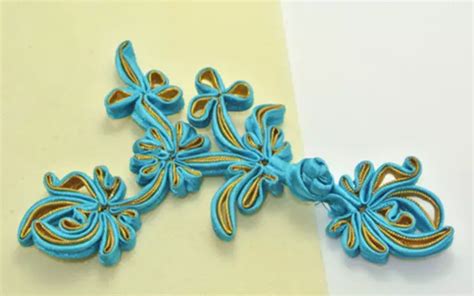Frog Fasteners: From Scrap Fabric to Stunning Detail
Frog fasteners, those charming little fabric loops and buttons, are more than just closures; they're miniature works of art. They add a touch of whimsy and elegance to garments, transforming simple pieces into handcrafted treasures. This article delves into the world of frog fasteners, exploring their history, construction techniques, and the creative possibilities they unlock. Whether you're a seasoned sewer or a curious beginner, discover how these delightful details elevate your sewing projects from ordinary to extraordinary.
What are Frog Fasteners?
Frog fasteners, also known as frog closures or simply frogs, are decorative closures consisting of a loop (often called the "frog") and a button (the "toad"). The loop is typically made from fabric, braided cords, or even yarn, while the button can be anything from a simple fabric-covered button to a more elaborate embellishment. The visual appeal stems from their unique shape and the opportunity for creative embellishment. They’re a delightful alternative to standard buttons, zippers, or hooks and eyes.
The History of Frog Fasteners
While pinpointing the precise origins of frog fasteners is difficult, their popularity surged in the Victorian era and the early 20th century. They became associated with high fashion and intricate handcraftsmanship, often adorning luxurious garments and accessories. Their enduring appeal lies in their timeless elegance and adaptability to various styles. They've seen revivals in recent years, making a comeback in contemporary fashion and craft projects.
How to Make Frog Fasteners: A Step-by-Step Guide
Creating your own frog fasteners is a rewarding experience, allowing you to personalize your projects with unique and beautiful closures. Here's a basic guide:
Materials:
- Fabric scraps (different textures and colors add interest)
- Button(s) – you can use pre-made buttons or create your own from fabric scraps.
- Needle and thread to match your fabrics
- Scissors
- Optional embellishments: beads, sequins, embroidery floss
Instructions:
- Cut Fabric Strips: Cut fabric strips of your desired width and length. The length will determine the size of your frog.
- Create the Loop: Fold the fabric strip lengthwise and stitch the edges together, leaving one end open. Turn the tube right side out. Depending on the desired look, you can stitch the open end closed.
- Shape the Loop (optional): For a more structured frog, you can add some stuffing or padding to the loop before closing the open end.
- Embellishment: Decorate the frog with embroidery, beads, sequins, or other embellishments. Get creative!
- Attach the Button: Sew the button securely to the garment where you intend to fasten it. Ensure it's firmly attached to avoid it tearing loose from the fabric.
Advanced Techniques:
- Braided Frogs: Create loops from braided cords or yarns for a different texture and look.
- Fabric-Covered Buttons: Cover buttons with fabric scraps to coordinate with your loops, adding a cohesive look.
- Mixed Media Frogs: Combine different materials like fabric, beads, and ribbon for a more eclectic design.
Where to Use Frog Fasteners: Unleashing Your Creativity
The applications of frog fasteners are virtually limitless:
- Cardigans and Jackets: Add a touch of vintage charm to cardigans and jackets.
- Coats and Wraps: Create a unique and decorative closure for your outerwear.
- Bags and Purses: Enhance the visual appeal of your handcrafted bags.
- Pillows and Cushions: Use them as decorative accents, even if they don’t need fastening.
- Kids’ Clothing: Frog fasteners add a playful and unique element to children's clothes.
Beyond the Basics: Exploring Different Frog Fastener Styles
Frog fasteners aren't limited to simple loops and buttons. Experiment with different techniques and materials to create unique designs:
- Varying Loop Sizes and Shapes: Experiment with different widths and lengths of fabric strips to create loops of varying sizes and shapes.
- Incorporating Different Textures: Combine different textures like silk, linen, or cotton for a more dimensional look.
- Embroidery and Appliqué: Use embroidery or appliqué to add intricate designs to both the loops and buttons.
Frequently Asked Questions
What kind of fabric is best for making frog fasteners?
Almost any fabric will work, but firmer fabrics like cotton, linen, or even upholstery weight fabrics will hold their shape better. Avoid very flimsy fabrics that might easily fray or tear.
How do I attach frog fasteners securely?
Use strong thread and secure stitches to attach both the loop and the button to ensure durability. Consider using a button shank or adding a small button for extra security on heavier fabric.
Can I machine sew frog fasteners?
While you can machine sew certain aspects of making the loops and buttons (such as stitching the fabric strips), you’ll likely need to hand-sew them onto your garment for a neat and secure finish.
Where can I find inspiration for frog fastener designs?
Look to vintage patterns, online tutorials, and craft blogs for inspiration. Don't be afraid to experiment and develop your own unique designs.
In conclusion, frog fasteners are a versatile and visually appealing closure option that adds a touch of elegance and personality to any project. With a little creativity and practice, you can transform simple fabric scraps into stunning details that elevate your sewing from ordinary to extraordinary. Embrace the charm of frog fasteners and let your creativity flourish!

